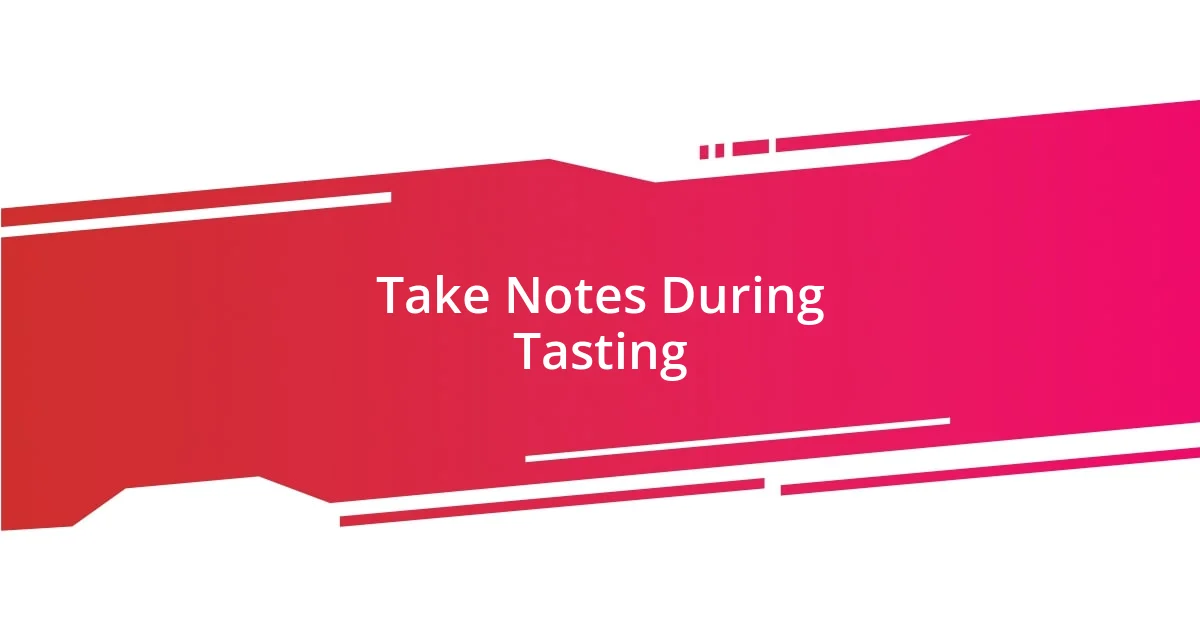Key takeaways:
- Choosing the right glassware enhances beer aroma and flavor, making tastings more enjoyable.
- Understanding different beer styles, including their unique flavors and serving temperatures, deepens appreciation and elevates tasting experiences.
- Exploring local breweries and attending craft beer festivals provides personal connections to brewers and opportunities to broaden one’s palate through diverse tastings.

Choose the Right Glassware
The right glassware can truly elevate your craft beer experience. I remember attending a tasting where the differences were astonishing—each beer seemed to sing in a proper glass. The wide bowl of a tulip glass, for instance, enhances the aroma, allowing you to appreciate the subtle notes that might get lost otherwise. Do you ever feel like your favorite beer is just missing something? Choosing the right glass might just be the secret ingredient.
Consider the type of beer you’re sampling; it can make a world of difference. I once sipped a rich stout from a sturdy pint glass, and it was fine, but when I switched to a snifter, the flavors became more pronounced. Have you noticed how certain glasses even make you feel more refined? It adds an element of elegance to the tasting experience, almost as if the beer itself is elevated simply by its vessel.
Don’t just grab whatever is handy; think about what will best complement your beer’s characteristics. I find that an unassuming pilsner glass can really showcase a clean lager, while a wide-mouthed glass works wonders for hop-heavy IPAs, releasing those vibrant aromas. What’s your go-to choice when reaching for a drink? Trust me, experimenting with glassware can turn an ordinary taste test into an extraordinary journey.

Understand Beer Styles
Understanding beer styles is essential for a memorable tasting experience. Each style carries distinct flavors, aromas, and mouthfeels that can transform how you perceive a beer. I recall my first encounter with a Belgian witbier; the citrus and spice notes were enchanting, revealing how diverse beer can be. It made me realize that knowing the characteristics of different styles isn’t just informative—it’s a gateway to deeper enjoyment.
When tasting various beer styles, keep these points in mind:
- Ales vs. Lagers: Ales are usually fruity and complex due to top fermentation, while lagers are cleaner and crisper because of bottom fermentation.
- Hoppy IPAs: The bitterness and aroma can range from piney to fruity, depending on the hops used.
- Sours: These beers offer tartness that many find refreshing; some can be quite whimsical in flavor.
- Stouts and Porters: Rich, dark beers with flavors reminiscent of chocolate, coffee, or caramel can be delightful, especially on cooler evenings.
Exploring these differences is like embarking on a taste adventure, and oh, what a delightful journey it can be! Each sip tells a story of the ingredients and processes that shaped it. Understanding beer styles not only enhances your tasting experience but also deepens your appreciation for this remarkable craft.

Consider the Serving Temperature
When it comes to beer tasting, serving temperature can significantly influence the flavors you experience. If you’ve ever enjoyed a warm ale, you might have noticed that the subtleties emerge more distinctly compared to a chilled version. I remember a summer barbecue where a light lager was served ice-cold; it was refreshing, but as it warmed slightly, those crisp, fruity notes became pronounced and delightful. Isn’t it interesting how a simple change in temperature can unlock hidden layers in your favorite brew?
Different styles thrive at specific temperatures, transforming the tasting experience. I learned this the hard way when I tried a rich imperial stout straight from the fridge; it felt too muted and almost lifeless. Once I let it warm up, those decadent chocolate and coffee flavors blossomed, turning my approach to beer tasting on its head. Have you experienced a similar revelation with temperature?
It’s crucial to experiment and take notes on how temperature affects your tastings. For example, I’ve found that wheat beers shine when served around 40-50°F, while bold ales benefit from a slightly higher range of 50-60°F. This pattern has become a guideline in my tastings, enhancing my overall enjoyment. Wherever you are in your beer journey, considering the serving temperature can truly elevate your experience!
| Beer Style | Ideal Serving Temperature |
|---|---|
| Wheat Beers | 40-50°F |
| IPAs | 45-55°F |
| Pale Ales | 45-55°F |
| Stouts | 50-60°F |
| Barleywines | 55-65°F |
| Strong Ales | 55-65°F |

Take Notes During Tasting
Taking notes during your beer tasting can be a game-changer. I often find that the flavors and aromas can blur together if I don’t jot things down. The first time I tried a series of IPAs, I was overwhelmed by their diversity. I’d wish I’d noted the specific profiles of each one because, by the time I reached the fifth sample, I struggled to distinguish the hoppy variations. Have you ever faced a similar challenge? It’s all too easy to forget distinct experiences without notes to jog your memory later.
When I started my tasting journey, my notes were simple—just a few keywords like “citrusy”, “bitter”, or “malty”. However, I realized the power of being more descriptive. Adding specific emotions or memories associated with a beer can turn your notes into a richer experience. For instance, I remember savoring a creamy oatmeal stout during a winter gathering. It brought back delightful memories of cozy nights by the fire. Capturing those feelings not only enhances the tasting experience but also makes it fun to look back on my notes and relive those moments.
I recommend developing a system that works for you—multiple categories or checkboxes can be incredibly helpful. After a recent tasting, I started using a simple five-point scale for aroma, taste, and finish, along with space for personal comments. It sounds a bit clinical, but it adds structure to my chaos. Have you found ways to tailor your note-taking style? Ultimately, diving into this practice can enable you to truly savor and appreciate the nuances in every pour, transforming beer tasting into an unforgettable adventure.

Pair Beer with Food
Pairing beer with food can elevate the entire dining experience. I remember enjoying a spicy Thai curry paired with a crisp, citrusy IPA. The bitterness of the beer cut through the heat of the dish, creating a balance that had my taste buds dancing. Have you ever thought about how certain flavors can complement each other so beautifully?
Another memorable pairing came during a casual dinner where I served a rich stout alongside a decadent chocolate dessert. As I took my first sip, the chocolate notes in the stout unfolded harmoniously with the dessert, intensifying the sweetness in the most delightful way. It was a reminder of the magic that happens when beer and food join forces. I love experimenting with different styles and discovering what combinations surprise me the most.
If you’re uncertain about where to start, I recommend thinking about flavor profiles. For instance, lighter brews often work well with salads and seafood, whereas hearty ales can hold their own against grilled meats or rich cheeses. Trust me, exploring these pairings can add a whole new level of enjoyment to your meals, turning an ordinary dinner into something truly remarkable. What’s the most surprising beer and food pair you’ve ever tried?

Explore Local Breweries
Exploring local breweries is one of the most rewarding experiences for any craft beer enthusiast. During a recent Saturday outing, my friends and I discovered a hidden gem tucked away in an unassuming alley. As we sipped on their house-made saison, the brewmaster stopped by our table to share his passion for funky fermentation methods. It really was a treat to connect directly with the person behind the beer, shedding light on the intricate craft involved. Have you ever enjoyed such a personal touch at a brewery?
I find that each local brewery has its own unique personality, often reflected in their beer selection. One time, I visited a microbrewery that specialized in small-batch experiments. They had a chili-infused lager that surprised me; the heat mingled with the crispness in a way I’d never expected. It’s these unexpected flavors that make exploring local spots so exciting—every visit can lead to a delightful revelation. Who knows what quirky recipes you’ll stumble across next?
Additionally, small breweries often host events that showcase their creativity, like seasonal launches or beer-and-cheese pairings. I attended a cozy night featuring a flight of their sour ales, each paired with artisanal cheeses from the region. The rich conversations among fellow enthusiasts were just as memorable as the unique flavors. Engaging with the community in this way never fails to deepen my appreciation for what’s being poured around us. Have you had the chance to engage with local beer lovers like this?

Attend Craft Beer Festivals
Attending craft beer festivals is an experience I genuinely cherish. Just last summer, I found myself at a bustling festival where the atmosphere was electric. As I wandered from booth to booth, sampling everything from barrel-aged stouts to zesty IPAs, I felt a sense of camaraderie among fellow beer lovers. Have you ever noticed how festivals turn strangers into friends, all united by a shared passion for craft beer?
One of my favorite moments was when I stumbled upon a small brewery showcasing their innovative fruit-infused brews. The excitement in the air was palpable as they explained their sourcing process for fresh, local ingredients. I remember sipping a peach tart wheat ale while chatting with the brewers, who were passionate about their craft. It’s those personal stories that bring the beer to life and make the tasting experience truly unforgettable. What’s the most interesting story you’ve heard from a brewer?
The tastings at craft beer festivals also offer a fantastic opportunity to expand your palate. I encourage everyone to step out of their comfort zone and try styles they wouldn’t ordinarily choose. I recall taking a chance on a spiced winter ale that I initially hesitated over, but it turned out to be a delightful surprise. It’s incredible how these events can open up new horizons and inspire your future brewing adventures. Have you ever discovered a new favorite at a festival that you wouldn’t have tried otherwise?















